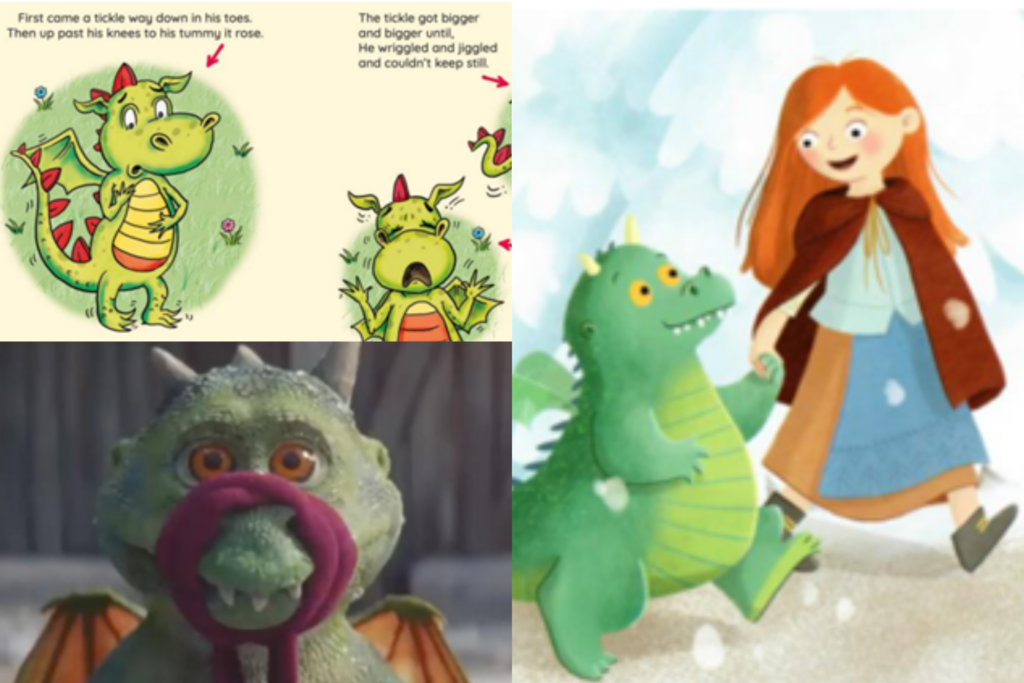
A fiery copyright infringement battle: Fay Evans v John Lewis PLC and DDB UK Ltd

John Lewis and its advertising agency adam&eveDDB have won a case in the Intellectual Property Enterprise Court against children’s author Fay Evans. Ms Evans brought a case for copyright infringement, alleging that there was a "striking similarity" between the dragon in her children's book and John Lewis' 2019 Christmas advert featuring a dragon. The claim was dismissed, holding that there was no copyright infringement.
What were Ms Evans' claims?
Ms Evans' book, "Fred the Fire-Sneezing Dragon", was published in 2017. It is a story about a dragon pupil in a school otherwise populated by human characters, whose fiery sneezes cause chaos. In Christmas 2019, John Lewis' advert told the story of a CGI-created dragon named Edgar, who when living in the human world accidentally caused issues by emitting flames. The advert was turned into an illustrated children's book by publisher Nosy Crow.
Images of Fred alongside Edgar, in the advert and the book, are reproduced below:

Bottom left: Edgar the dragon from the 2019 television advert.
Right: The book version of Edgar published by Nosy Crow.
Ms Evans asserted that Fred the Fire-Sneezing Dragon contained original literary and artistic works and submitted that Edgar reproduces other features of Fred which amount to elements of the expression of the intellectual creation contained in her book. Namely, that the dragon is child-sized and has a green colour, ribbed front, triangular spikes on head and back, two arms, some facial features and has the general body shape of the dragon in the claimant's book.
As a result, Ms Evans claimed that Edgar in the 2019 television advert and book reproduced elements of the expression of the intellectual creation contained in her book about Fred, which are not found in the 2016 outline of the dragon as created by adam&eveDDB. As such, Ms Evans sought:
- Damages or an account of profits.
- An injunction against further copyright infringement in her Fred dragon.
- An order for delivery up of infringing materials or articles.
- An order for dissemination.
- Publication of any judgement/order made in this case at the defendant's expense, costs and interest.
What was the Court's decision?
The Court examined the degree of familiarity, character, and objective similarity of the works necessary to establish copyright infringement. Summarised below are Judge Clarke's key findings:
- On the balance of probabilities, there was no access to Fred the Dragon by any of the creatives involved in the creation of Edgar since they had not seen Fred the dragon until after the 2019 advert and book were produced. As a result, there could not have been any copying.
- This lack of access was deduced since Fred the Fire-Sneezing Dragon was sold in very small numbers and up to 31 October 2019 only 914 copies of Fred the Fire-Sneezing Dragon had been sold (700 of which were sold following primary school visits).
- The idea for the Christmas advert was conjured up by a creative at adam&eveDDB in 2016, before Ms Evans’ book was published.
- Judge Clarke highlighted in considerable detail that use of a dragon creature dated back to ancient times and was found in cultures across the world, though “as a mythic animal, its appearance, characteristics and personality are not fixed, but have been reinterpreted through the years to suit the purposes and culture of the person utilising it”. Also, the dragon’s features as detailed in the 2016 outline, such as the spikes down the full length of back and tail, two arms, a ribbed stomach, and triangular spikes were “entirely commonplace features, almost ubiquitous in depictions of dragons”.
- Noting also that the idea of dragons sneezing and breathing fire was very old, Judge Clarke commented that the parties’ use of dragons had been treated quite differently, in terms of both the detail of those features, and their colour and general appearance.
- As to the features that Ms Evans alleged had been reproduced, Judge Clarke concluded that although the choice of Fred being child sized, having ribbed fronts and spikes was protected by copyright, there was not a sufficient similarity in the size chosen for Edgar in the television advert and Fred to raise a presumption of copyright infringement. For example, Edgar was seemingly the height of a 4-5-year-old child, which appeared quite different to Fred. Moreover, the judge was not satisfied that the green colour is an element of Fred’s appearance amounting to expression of claimant’s own intellectual creation such that it was protected by copyright.
- Accordingly, the features found in John Lewis’ 2016 outline did not result from copying. Any similarities could easily be explained by coincidence.
Highlighting John Lewis' reputational concerns of potentially being tarnished by allegations of copyright infringement, Judge Clarke commented that they "exit this litigation without the slightest hint or stain on their creative integrity".
The claim was dismissed and John Lewis' counterclaim for making a declaration of non-infringement and a publicity order was upheld. Judge Clarke ruled that the retailer’s advert, and the accompanying illustrated children's book, did not infringe the claimant's copyright. Ms Evans was directed to publicise the judgement on her website, Facebook and Twitter pages for at least 6 months as a means to provide justice to the defendants and protect their creative integrity.
Thoughts on the decision
The decision echoes the principle that copyright subsists in intellectual creations/expressions and not merely the idea behind them. While the judge's finding that the general idea of a fire breathing dragon causing havoc in a human world unsurprisingly did not attract copyright protection, the decision acts as a reminder of the available remedies to a successful party. This included a publicity order against Ms Evans in attempt to redress the criticisms against John Lewis and DDB.
Bethany Wheeler-Fowler, Solicitor
This decision serves as a timely reminder of the threshold required for copyright infringement – copying of a work is required, which of course cannot occur if the work has not been accessed by the purported defendants.
Prem Shah, Trainee Solicitor











